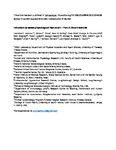| dc.creator | Leonidas G. Ioannou | en |
| dc.creator | Petros C. Dinas | en |
| dc.creator | Sean R. Notley | en |
| dc.creator | Flora Gofa | en |
| dc.creator | George A. Gourzoulidis | en |
| dc.creator | Matt Brearley | en |
| dc.creator | Yoram Epstein | en |
| dc.creator | George Havenith | en |
| dc.creator | Michael N. Sawka | en |
| dc.creator | Peter Bröde | en |
| dc.creator | Igor B. Mekjavic | en |
| dc.creator | Glen P. Kenny | en |
| dc.creator | Thomas E. Bernard | en |
| dc.creator | Lars Nybo | en |
| dc.creator | Andreas D. Flouris | en |
| dc.date.accessioned | 2022-04-19T10:31:20Z | |
| dc.date.available | 2022-04-19T10:31:20Z | |
| dc.date.issued | 2022 | |
| dc.identifier | 10.1080/23328940.2022.2044738 | |
| dc.identifier.issn | 2332-8940 | |
| dc.identifier.issn | 2332-8959 | |
| dc.identifier.uri | http://hdl.handle.net/11615/59314 | |
| dc.description.abstract | In a series of three companion papers published in this Journal, we identify and validate the available thermal stress indicators (TSIs). In this second paper of the series, we identified the criteria to consider when adopting a TSI to protect individuals who work in the heat, and we weighed their relative importance using a Delphi exercise with 20 experts. Two Delphi iterations were adequate to reach consensus within the expert panel (Cronbach’s α = 0.86) for a set of 17 criteria with varying weights that should be considered when adopting a TSI to protect individuals who work in the heat. These criteria considered physiological parameters such as core/skin/mean body temperature, heart rate, and hydration status, as well as practicality, cost effectiveness, and health guidance issues. The 17 criteria were distributed across three occupational health-and-safety pillars: (i) contribution to improving occupational health (55% of total importance), (ii) mitigation of worker physiological strain (35.5% of total importance), and (iii) cost-effectiveness (9.5% of total importance). Three criteria [(i) relationship of a TSI with core temperature, (ii) having categories indicating the level of heat stress experienced by workers, and (iii) using its heat stress categories to provide recommendations for occupational safety and health] were considered significantly more important when selecting a TSI for protecting individuals who work in the heat, accumulating 37.2 percentage points. These 17 criteria allow the validation and comparison of TSIs that presently exist as well as those that may be developed in the coming years. | en |
| dc.source | Temperature | en |
| dc.subject | Consensus | en |
| dc.subject | occupational | en |
| dc.subject | heat strain | en |
| dc.subject | work | en |
| dc.subject | labor | en |
| dc.subject | temperature | en |
| dc.subject | hyperthermia | en |
| dc.subject | thermal indices | en |
| dc.subject | heat indices | en |
| dc.subject | criteria | en |
| dc.title | Indicators to assess physiological heat strain – Part 2: Delphi exercise | en |
| dc.type | journalArticle | en |
| dc.identifier.bibliographicCitation | Leonidas G. Ioannou, Petros C. Dinas, Sean R. Notley, Flora Gofa, George A. Gourzoulidis, Matt Brearley, Yoram Epstein, George Havenith, Michael N. Sawka, Peter Bröde, Igor B. Mekjavic, Glen P. Kenny, Thomas E. Bernard, Lars Nybo & Andreas D. Flouris (2022) Indicators to assess physiological heat strain – Part 2: Delphi exercise, Temperature, DOI: 10.1080/23328940.2022.2044738 | en |


